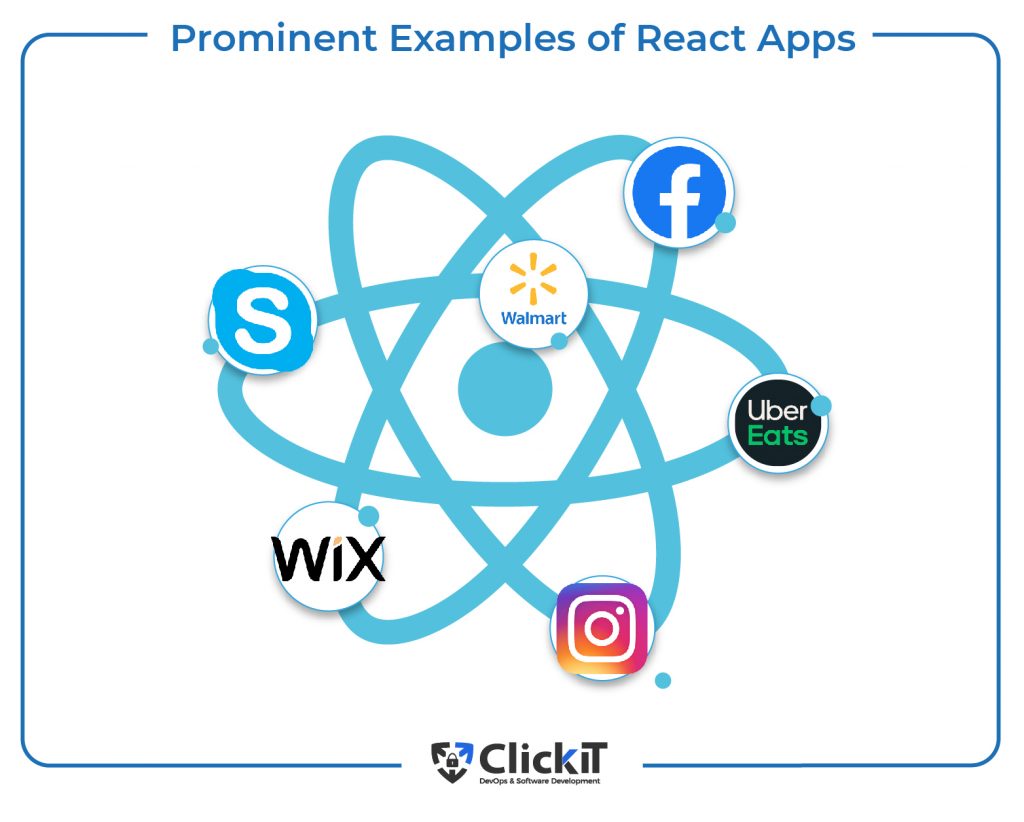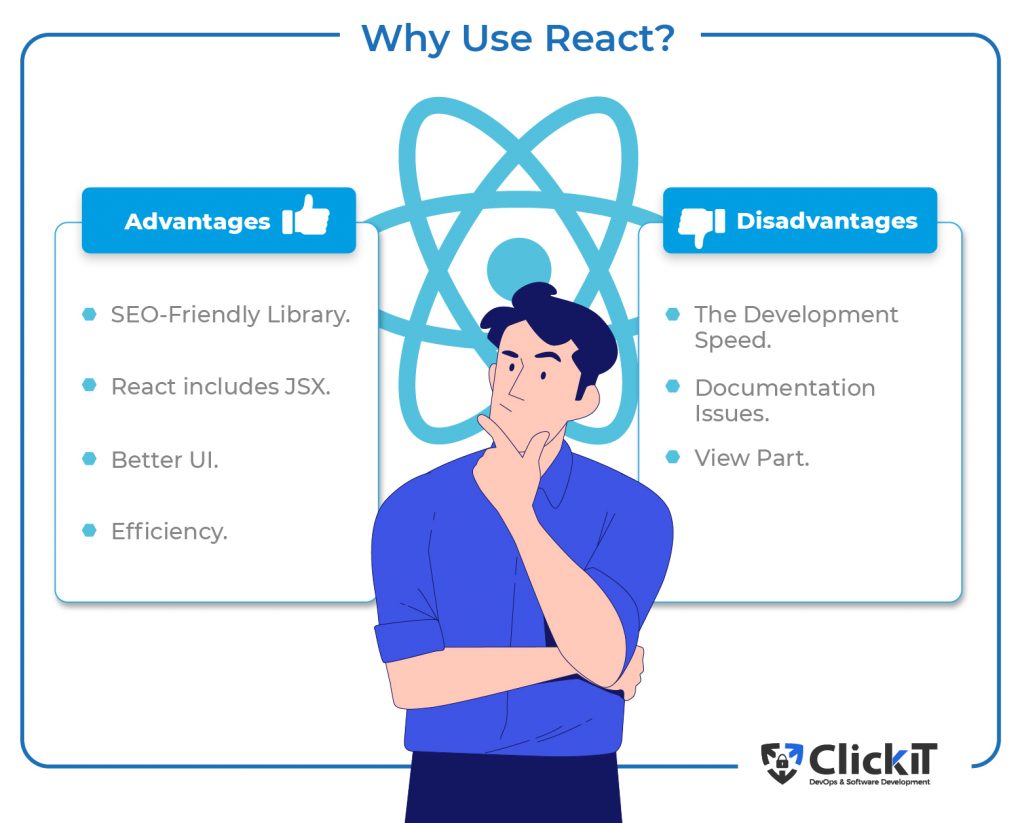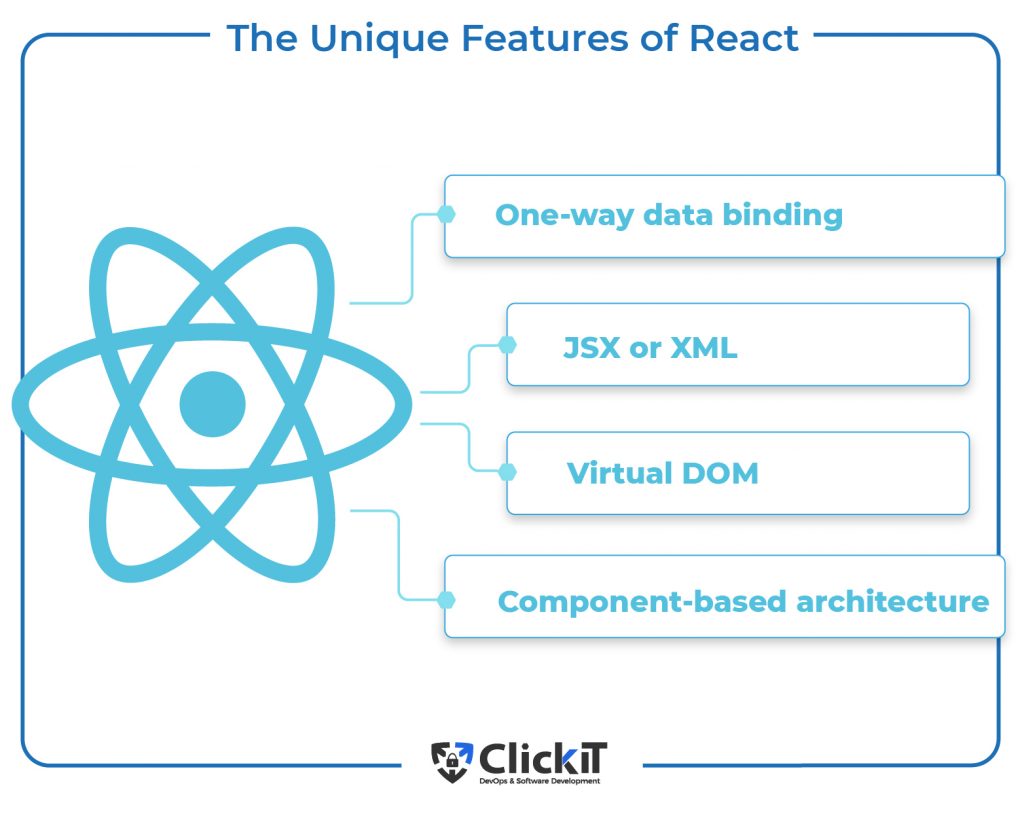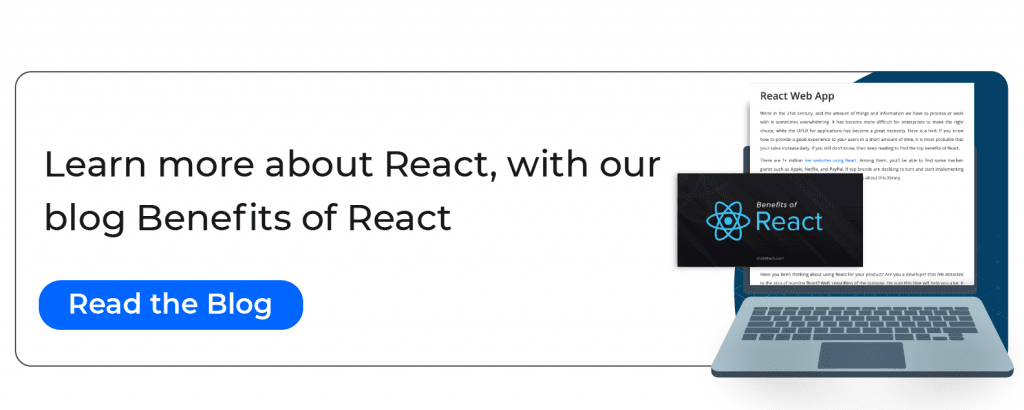The continuous evolution of the front-end development ecosystem makes it difficult for business owners to choose a framework. With React apps examples, it might be easier to make a good choice that resonates with their needs.
React is becoming a popular front-end development framework. It is already used on more than 10.2 million websites worldwide. React is a JavaScript-based UI development library administered by Facebook and an open-source developer community. According to a developer survey, React achieved the first position and beat most front-end development frameworks.
React’s benefits include its SEO-friendliness, use of JSX, efficient performance, and ability to create better UIs. I present eight React apps Examples from various sectors, such as e-commerce (Walmart, Uber Eats), social media (Facebook, Instagram), communication (Skype), and healthcare (Gyroscope), that utilize React and React Native, illustrating their diverse use cases and advantages.
- Software as a Service (SAAS) Apps
- Chat Apps
- Healthcare Apps
- FinTech Apps
- Why Use React?
- What are some Disadvantages of React?
- What are the Unique Features of React?
- Your Professional Partner in Building Apps with React
- FAQs
We invite you to read our blog React vs. Angular to learn which framework is ideal for your projects.
React’s most prominent application is cross-platform app development. However, React development examples can also be found in the web and mobile app development spaces.
Here are examples of eight different categories of applicated React apps.

Software as a Service (SAAS) Apps
1. React app example: Walmart
Walmart is an international retail corporation based in the U.S. with a global network of 11,000 supermarkets. Their React-based software provides a frictionless online shopping experience, product search, and in-store pricing comparison.
Developers say React Native enabled the reuse of about 95% of the code base across the two platforms. Moreover, they only needed a single team of JavaScript developers to complete the job. Walmart aimed to target many platforms without creating additional code and grow its user base beyond iOS.
According to Walmart, the primary advantage of collaborating as a React Native app example, is the opportunity to employ the same automation suite across both platforms. It helps increase the speed of the apps on both iOS and Android platforms.
It also helped them gain greater control over announcing update release dates. Along with boosting performance, another objective was to improve the client experience.
2 . React app example: Uber Eats
Uber Eats is an example of a React Native app. It is a meal delivery service and an extension of Uber’s original ride-hailing business. It is an on-demand online food delivery service that operates as a mediator between you and restaurants, delivering take-out from independent and chain restaurants directly to your home.
React Native provided the development team with outstanding knowledge and features for react native app development, which enhanced the user experience. Even though React Native only makes up a tiny percentage of UberEats’ vast technological stack, functioning from behind, its contribution is noteworthy.
It introduced the most significant modifications in the Restaurant Dashboard overhaul. It has empowered, streamlined, and enhanced the responsiveness of this operational component. This framework undoubtedly increased the capacity of the app without increasing its complexity by combining web and mobile development.
3. React app example: Wix
Wix is a popular cloud-based website builder service and a React Native app example. Wix enables consumers to create websites without requiring them to possess specialized expertise or employ web experts. The sites are mobile-friendly and can be quickly constructed, updated, and managed via the Wix website. Whatever the user’s level of expertise, Wix provides a solution for developing sites.
React has helped Wix deal with obstacles associated with early adaptation and stay on track, providing agility to the development process, which is easier to conduct. In addition, contributing to the core project of the React Native app while also maintaining the fork for critical fixes has been possible.
Implementation of React has also made it possible to create other projects like react-native-navigation, react-native-notifications, react-native-UI-lib, and react-native-calendars, which are all still active and growing daily.
Chat Apps
4. React app example: Facebook
Facebook is a social networking platform that enables you to interact with and share information with family and friends. Initially intended for college students, Mark Zuckerberg founded Facebook in 2004. By 2006, Facebook was open to anybody over 13 with a verified email address. Today, Facebook is the most important social networking platform globally, with over 1 billion members.
Although Facebook uses React only in part, its website is designed using React, a scripting language integrated into the application’s code. The mobile application is also constructed using React Native, which is similar to React but is responsible for displaying native iOS and Android components rather than DOM elements.
Interestingly, Facebook is where the React library was born, so the app is a prime example of a React app. Facebook has launched a beta version of React Fiber, a redesigned React.
5. React app example: Skype
Skype, another react app example, is a cloud-based audio and video communications service that allows users to make and receive free voice and video conversations via the internet using a web browser, computer, or mobile phone. VoIP offers communication that is not reliant on traditional landlines or cellular plans.
The corporation carried over virtually all of the features from the previous version of Skype and added a slew of new ones. Microsoft, for example, has incorporated Giphy, which enables users to exchange animated GIF files during discussions.
6. React app example: Instagram
Instagram, a social networking site focused on picture and video sharing, is also a React app example. It was first released for iPhone and then Android. Facebook acquired the service in April 2012 and has retained ownership since then.
Instagram extensively uses React. Numerous elements, such as Google Maps APIs, geolocations, search engine accuracy, and tags that appear without hashtags, attest to this. About 90% of the code is shared between iOS and Android platforms. Instagram is built entirely on React technology, which has allowed users to adapt quickly to its incredible features and deliver products swiftly.
Healthcare Apps
7. React app example: Gyroscope
Gyroscope is a smartphone application that integrates with Apple Health to give personalized health dashboards and coaching based on your data. Utilize your Apple Watch and in-app monitoring to be informed of every activity.
Gyroscope grants access to the device’s gyroscope sensor, which detects rotational shifts in three-dimensional space. The software, which was built using React, provides users with several unique benefits, such as interacting with the data manually or digitally, and all data may be consolidated on a monthly, annual, or even weekly basis.
FinTech Apps
8. React app example: Facebook Ads
Facebook Ads are only available on the Facebook advertising platform. They may display in Facebook’s news feed, Messenger, and even on non-Facebook applications and websites. They are available in several formats—single picture, video, slideshow, and more—and may be customized to reach extremely particular populations.
Facebook is not the company’s sole React Native app; Facebook Ads was the company’s first React Native application on Android and the first cross-platform React Native app example.
The program is lightning quick, regardless of the operations you choose to do; from monitoring the success of an existing campaign to launching a new one, it takes no more than a second or two to go to the next level or access data.
After learning about these apps, you may wonder how you can create your own. Check out this blog on how to build your fintech app.
Why Use React?
Businesses choosing React for their front-end development projects see several benefits. The benefits also justify the selection of React as a framework by the eight prominent companies we will talk about in the following sections. Let’s review a few of these benefits:
- Compatible with AI-powered interfaces: its ecosystem allows seamless integration of machine learning libraries and AI APIs (think chatbots, voice assistants, or personalization engines) directly into the user interface. This means developers can easily connect to back-end AI services or third-party APIs to embed advanced intelligence, all while leveraging React’s broader strengths
- SEO-Friendly Library. Search engine optimization is critical to the success of any online company. According to Moz, the quicker a website loads and the more quickly an app renders, the better the app will rank on Google. Due to its quick rendering, React dramatically decreases website load time compared to other frameworks, which notably aids companies in attaining the top spot on Google’s search engine results page.
- JSX. React includes JSX, an optional syntactic extension that enables the creation of custom components. These components effectively support HTML quoting and make subcomponent rendering a joy for developers. Despite several disputes over JSX, it has already been used for bespoke component development, high-volume application development, and turning HTML mockups into React element trees.
- Better UI. The quality of an application’s user interface is critical. If the UI is not designed well, the likelihood of a program succeeding decreases. React’s declarative components enable the creation of high-quality, rich user interfaces, which leads us to our next point.
- Efficiency. React stores the components in a virtual DOM. This method provides developers unprecedented flexibility and performance improvements since React anticipates which changes need to be made to the virtual DOM and appropriately updates the DOM trees.

You can also read our slideshow about the top reasons to choose React.
What are some Disadvantages of React?
It’s worth noting that there are some issues developers find hard to tackle in React:
- The Development Speed. Rapid progress can bring both advantages and disadvantages. Since the environment constantly changes, some developers may not feel comfortable relearning new methods frequently.
- Documentation Issues. This is another disadvantage associated with rapidly evolving technology. React technologies evolve and develop quickly, leaving little time for appropriate documentation.
- View Part. React is limited to the application’s UI layers. As a result, you have to choose a few other UI frameworks like React.bootstrap, Material UI, CSS Grids, or Flexbox for comprehensive UI development.
Many business owners don’t see the above drawbacks as obstacles to their development projects. So, before diving into react apps examples, let’s check out why React can be a better choice than other frameworks.
This blog is also available on our DZone profile
What are the Unique Features of React?
React features a few unique elements that make it stand out from the crowd of other JS-based frameworks:
- Virtual DOM. This feature of React contributes to the development process’s speed and flexibility. The method enables React’s virtual memory to replicate a web page. Whenever an app is edited or updated, the virtual DOM recreates the complete UI by updating all the customized components. This significantly decreases the time and expense associated with development.
- JSX or XML is a markup syntax that describes the look of an application’s interface. It converts the syntax to HTML, which developers use to generate React components. JSX is one of the best aspects of ReactJS since it simplifies the process of developing building pieces.
- One-way data binding. This implies that React employs a unidirectional data flow, requiring developers to change components through the callback features and prohibiting them from altering them directly. Controlling data flow from a single location is accomplished using an element of the JS app called Flux. It gives developers greater control over the software, increasing its flexibility and effectiveness.
- Component-based architecture. React.js is a component-based framework. In other words, a React-based web application’s user interface comprises several components. Every component has its logic, so rather than utilizing templates, the logic is written in JavaScript. This allows developers of React applications to transfer data throughout the application without altering the DOM.

While the above unique features can prove effective against most other web development frameworks, it is important to learn a few use cases of React.

Your Professional Partner in Building Apps with React
Read our blog Vue vs React to learn more about this debate.
When you decide to find a React developer after reading the above React app examples, you should consider a reliable partner for success. You should perform due diligence before selecting one to build your React applications.
After proper verification, you will know the key ingredients required to create a better React app. For instance, ClickIT ensures the following aspects during a React app development journey:
- React migration. Migrating to React has never been easier and hassle-free. Regardless of the platform you are on right now, ClickIT will help you switch to it.
- Refactor React code. Refactoring codes can be done anytime with the help of expert developers who know what they are dealing with.
- Dedicated React developers. ClickIT offers developers who are highly specialized in React.
- Building from scratch. It’s always best to create an app with React from scratch. Such practices let developers design more efficiently and solve critical issues, keeping React in mind. ClickIT is very interested in such projects.
Finally, suppose you are convinced that features like React migration, dedicated developers, or starting from scratch are enough to get started. In that case, you should collaborate with a developer company such as ClickIT.
Read our guide on hiring a React developer to find the perfect expert.
There is no question that React is one of the best choices for developing web—or mobile-based applications. However, many businesses struggle to decide which framework will work best for their platforms.
So, when we see examples of React apps or React Native apps from top enterprises like Facebook, Walmart, and Instagram, adopting similar frameworks for your development needs makes sense. You need a trusted partner like ClickIT who can understand your requirements.

FAQs
Using React, you can make apps similar to Artsy (an online art marketplace), Bloomberg (a global news app), and Cake (a simple language learning app).
Also, some prominent examples of React apps you can replicate are Facebook chats, Instagram, Facebook ads, and Uber Eats.
Here are the top website examples of React apps:
-Asana
-British Broadcasting Corporation (BBC)
-Dropbox
-Facebook
-Netflix
-Salesforce
The iOS calculator, emoji search apps, and image compressors are smaller examples.
In React, the app component is the primary element that serves as a container for all other components. This is the associated CSS file for the app component.
There’s also a build folder where all the built files are stored. Developers can either use JSX or JavaScript (normal) to develop React apps.
Here’s an eight-step process to build a React application:
Step 1: Create the React app on your terminal.
Step 2: Start installing the React app.
Step 3: Determine the component structures.
Step 4: Use the Rails API to set up the backend.
Step 5: Set up the app components.
Step 6: Nav components for presentation.
Step 7: Set up the create card component.
Step 8: Create the main element.
Using these processes, you can fetch data, build simple listings, or display short blog posts.
You can also use Bootstrap to style your application. Following the above steps makes making your first React app easy.
In 2025, AI-focused companies are gravitating towards React for front-end development due to its synergy with intelligent technologies. React’s scalability and flexibility make it ideal for complex, data-heavy AI applications, thanks to a component-based architecture that keeps code modular and maintainable. React’s evolution aligns perfectly with 2025’s tech trends, giving AI-driven teams a robust, future-proof toolkit for building engaging and intelligent user interfaces.









